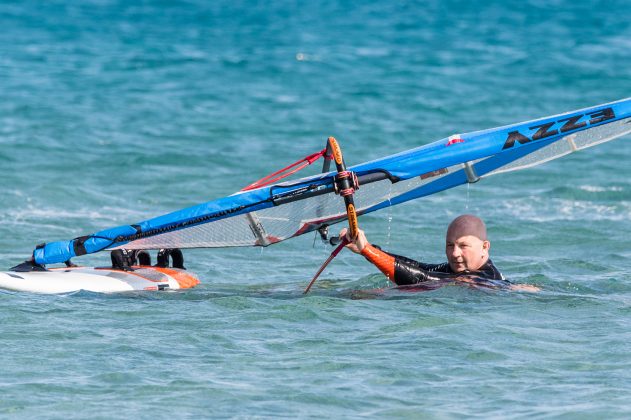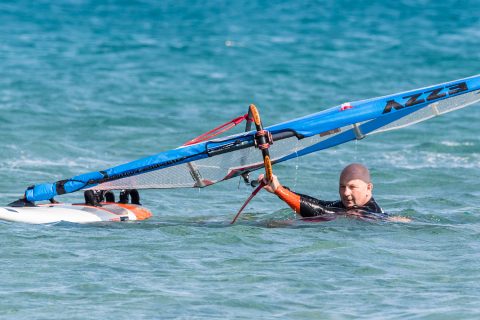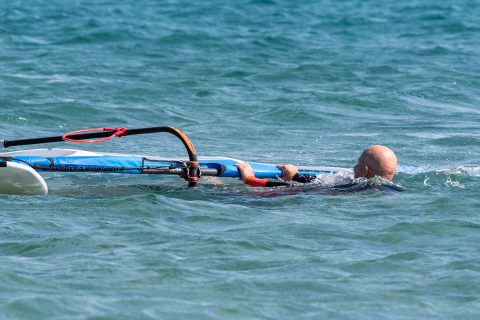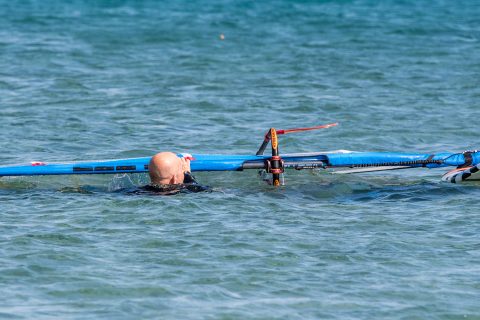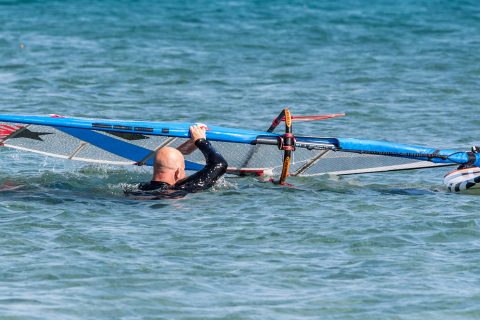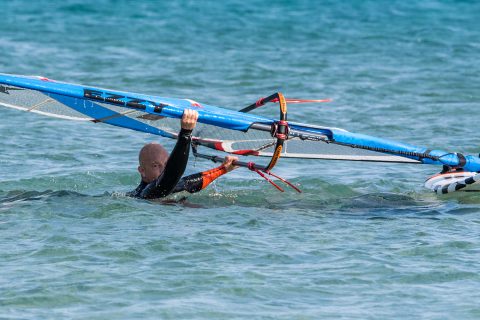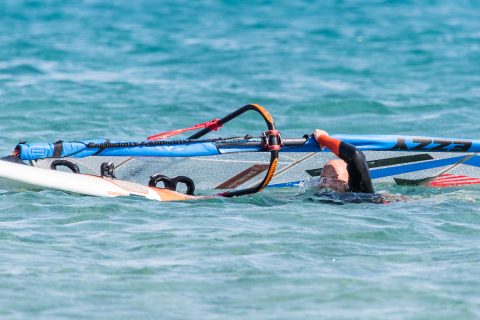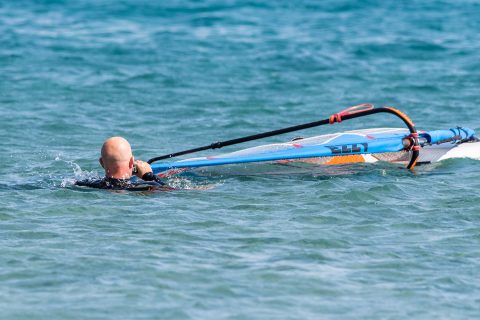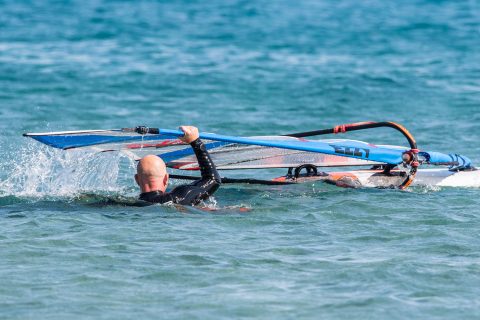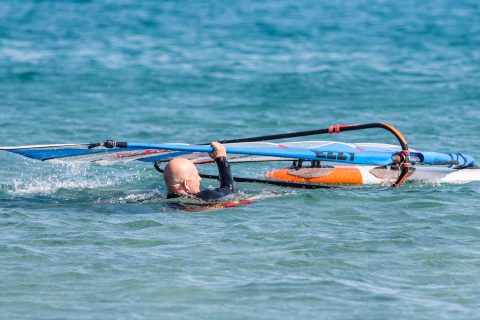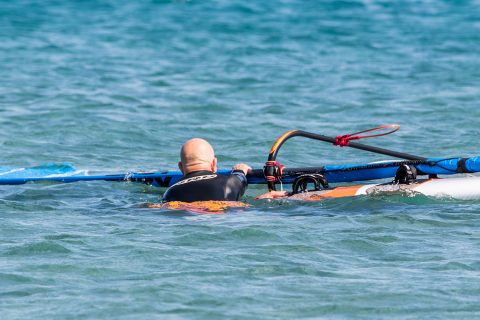JEM HALL
MOVE ON UP – WINDSURFING TECHNIQUE
RIG RECOVERY
From our April 2021 edition, Jem Hall looks at rig recovery for waterstarts, with tips to get that darn rig out of the water efficiently, and more often, so lethim give you the tools to make that happen.
Photos: Eye Sea You Photo
GREAT HABITS
To start, here are some top tips on how to clear the rig, for all levels!
- Work with the wind – think about how the wind can help ‘lift’ your rig, from carrying it and securing it on the beach, to then launching your kit.
- Feel a lift – now that you are wind conscious, use the wind to carry your board and rig. This helps teach you how to control the lift that wind can give a sail. If you are not sure, ask someone accomplished for some tips or a demo.
- Forwards not backwards – how many people have you seen walk backwards to or from the water? Why? This is because they either do not know how to flip the sail or they do not focus enough to do it. Position the rig with the mastfoot pointing into the wind and then walk the clew 15 degrees towards the wind, lift it from the boom and then the wind will do the work for you and flip the sail. Then you can walk forwards with the wind flowing over the board.
- Pull across every time – your beach start habits affect your waterstarts, so when lifting the rig, ready to get in your start position, always pull it across you with your hand quite high on the mast, placed on the luff tube.
- Beach starts both ways – your beach start coming in is your waterstart on the outside to get back to the beach! So practice beach starts going out and coming in.
- Get physical – clearing the rig and getting up and away in waterstarts is quite physical, so being stronger in all areas and more flexible will really help. E.g. Kettelbell swings will definitely help clear your rig faster.
- Efficient rig clearances leave you in a better position, with more energy to waterstart faster
GIVE IT A LIFT
There are so many ways to clear the rig when waterstarting and the more you have in your toolbox the faster you are up and having fun.
Let’s look at what your options are:
- Airplane: this is where the wind is blowing straight towards the mast, with the nose often pointing towards the wind. To clear the rig you swim backwards and lift the mast across and over your head. This is the easiest method and the one to learn first.
- Mast tip: this is performed when the mast tip is facing into the wind, and you lift it from there, and it can be quite simple. It is less physical and you naturally arrive in the sweet spot after working your way down the mast.
- Over the back of the board: when the board is situated across the wind, and the rig is lying downwind from the back of the board, and the mast is proximal to it, then bringing the rig over the back of the board is the preferred method. It can get a bit congested in this position and it requires a strong clear across you.
- Over nose of board: when the rig falls downwind of the nose of the board and mast is near to it then we bring the rig over the nose of the board. Again it requires a strong clear across you, and then you have to swim to the sail and gybe / flip the sail above your head. So you will need those sail flipping skills.
- Clew raise and flip: should the clew be nearest to the wind it requires you to swim backwards with it and then lift it and let it flip with an ‘airplane’ recovery to follow. Again those sail flipping skills you learnt on land will really help here
There are a few more, but we will cover more extensively the first 2 scenarios, and then somewhat the 3rd scenario, across the back of the board. For more insights and some great demos, watch my Beginner to Winner DVD where you can see all the clearances, and the waterstart chapter is also on my YouTube channel.
- Swimming backwards towards the wind helps both you and the wind clear the sail for the ‘airplane’ method
AIRPLANE TIPS
- Kick or swim the nose: you can work on the rig to position the mast across the wind but it often helps to swim the nose, or kick it, so that it is directly into the wind. This also ensures you are focussed on your position, relative to the wind.
- Angle to attack: the best angle to draw the mast across you is 30 degrees. Too low and there is not enough wind to help, too high and the rig is too heavy or can get ripped out of your hands.
- Javelin throw: some people find it easier to swim side stroke and use their back hand to throw the rig across and guide it towards an outstretched front arm, waiting to catch it and keep it flying. This uses stronger muscle groups.
- Keep swimming: when learning, people forget to keep swimming backwards, if in doubt keep kicking to take you upwind.
- Down it: sink the mast again if the back edge catches. This avoids the sail getting flipped, and ripped out of your hands. This means you can go again and this time with more swimming and gusto.
- Wait: if the wind is light, or gusty, then wait for a nice gust of wind to come so it can help you clear the rig and provide more energy to get you up and out.
- Get high: if the sail is big, or it is not clearing after a few attempts, then go higher up the mast to give you more leverage.
- Ensure you have the wind hitting the mast at 90° and after you have swam backwards with the rig, begin to draw it up and across to draw air underneath it. You can do this with one hand once you have released the water off the sail or with both hands.
- Now that the sail has lifted and you have seen and felt that all the water is off the leach of the sail you can continue to draw the mast up, across and over your head. Continue to gently kick your legs so you are still swimming upwind.
- You should now really feel the mast is across you and that you have a firm grip on it. Keep the mast at a good height for the wind available. Put your back hand on the boom. Check the wind and then your mast hand can go on the boom and you are ready to steer into your ‘sweet spot.
MAST TIP POINTERS
Lift and shake: it is quite a refined action, but you essentially lift the rig, give it a shake to release any water on the leech and then a little tug over your head.
Work down: own the rig and make positive movements with your mast hand about 50-70 cms at a time.
Orientation: as for most starts, really know where you are and what the wind is doing.
Keep it up: as you are working down the mast, keep the rig flying with your arm extended, but also through some gentle leg kicks to keep your body position high in the water.
- Trying to lift the sail without enough swimming or a rig across action will see you drinking plenty of seawater.
- When the rig falls into the wind it’s best to clear the rig from the mast tip. Check your wind direction and swim to the mast tip, lift it up with your front hand and bring it into the wind and give it a shake. It helps to be swimming backwards slightly.
- As you lift the rig continue to swim backwards and ensure you keep the rig flying, i.e. mast arm extended. You can slide your hand down the mast from the very top.
- Now lift the rig and release your mast arm and grab further down the mast. Then work down the mast whilst keeping the wind under the sail by holding the mast up. You should also be swimming in this direction, towards the tail of the board and your eventual ‘sweet spot’. When you get near the tail, place your back hand, and then your front hand on the boom, in readiness to get up and away.
Nick’s Nuggets:
Nick Jones has been with me on many trips, as my photographer, and he is very observant and a keen progressing windsurfer that is learning to wave sail and working hard on his gybes and tacks. Therefore he not only sees a lot of waterstarts, but he also does a huge amount. He has these awesome insights to offer:
“When it’s windy, the easiest and safest way to raise the sail is from close to the mast tip (head). If you raise the sail lower down the mast it is possible that the wind can rip the sail from your hand and you end up with the sail downwind of the board, with the clew into wind and so you have a full recovery manoeuvre to perform.
When raising the sail from the tip in a strong wind, the wind will instantly lift the clew clear of the water, making the rig light and therefore easy to hold up and the board will move dead downwind and there won’t be too much lift in the sail. It is then easy to pull the mast up through your hand and as you do so, due to the shape of the luff, the board will move around into the wind, so that when you reach the boom, you are in the ‘sweet spot’ to waterstart.
Another tip in windy conditions is to use the sail to give you a rest. When you have the sail over your head (holding the mast and back hand on the boom) I sometimes just wait in that position, because the sail has my weight so I can just take a moment and hang there, to take a breath, check the wind, and to focus on what I am going to do next, because as soon as both hands are on the boom it is action stations.
Kit:
Bigger boards can be too big as they sit so high in the water, go for 30 – 40 litres of volume over your body weight. E.g. 120 – 140 litres for a 90 kg person.
Medium sized sails, in relation to you, are best, 4.7 to 6.5 for example.
Take a board you can uphaul to give you confidence and options.
Try a lower boom than usual.
A rotational sail set not too full is easiest to fly.
Conditions:
Flatter water helps as there are less waves to affect the wind you need to help you lift the sail.
Stable wind in strength and direction is best for maximum progression.
Not too windy! Strong winds are angry and throw the sail around and give you less time to react.
Try it in lighter airs too, to get a feel for how the sail flows and floats.
Common mistakes:
Not taking account of the wind direction means you cannot let it help you.
Not swimming backwards towards the wind means the water stays on the sail and makes it very heavy.
Lifting the rig straight up forces you under the water and means you are not using the wind.
Clearing the rig and then losing focus so the board changes direction or the rig gets ripped out of your hands.
Not lifting the rig from the water high enough up the mast
- Back of the board rig clearing
Check the wind direction and then swim the kit so the mast is 90° to the wind with the board across the wind. From here get in position upwind towards the tail of the board and put your front hand on the mast above the boom. Your back hand goes onto the tail of the board. Being upwind and away from the board means you can lift the rig across and into the wind as your back hand sinks the tail.
This draws the wind under the sail and keeps the water off it and stops the clew from sinking. Really pull the rig hard across you and into the wind. You can then get into your ‘sweet spot’ with both hands on the boom.
RRD boards, wetsuits & softwear, Ezzy sails & Black Project fins sponsor Jem Hall. Get him live and direct on one of his highly acclaimed coaching holidays; check out his fab new site www.jemhall.com for details. You can also follow him on twitter / Facebook / Instagram.

